Distinguish between extension of demand and contraction of demand with the help of a diagram.
(b) What is 'movement along a demand curve'? Show it with the help of a diagram.
(c) What causes an upward movement along a demand curve of a commodity?
(a) Extension and contraction of demand. Rise in demand due to fall in price of a commodity itself, other things remaining the same, is called extension of demand. It results in downward movement along a demand curve. On the other hand, fall in demand due to rise in price of a commodity itself, other things remaining the same, is called contraction of demand. It results in upward movement along a demand curve. The following demand schedules and curve further clarify it.
|
EXTENSION OF DEMAND |
CONTRACTION OF DEMAND |
||
|
Price per unit (र) |
Demand (units) |
Price per unit (र) |
Demand (units) |
|
5 |
10 |
1 |
20 |
|
3 |
15 |
3 |
15 |
|
1 |
20 |
5 |
10 |
(b) Movement along a demand curve. A demand curve showing change in demand due to change in price (i.e., extension and contraction of demand) is graphically called movement along a demand curve. In Fig. 2.9 when price is OP, demand is OQ. But when price falls from OP to OP2, demand expands from OQ to OQ2 and we move downward along the demand curve. When price rises from OP to OP1, demand falls from OQ to OQ1 and we move upward the demand curve. Thus a change in demand due to change in price of the commodity graphically means movement along the demand curve.
(c) Rise in price or fall in demand causes an upward movement along a demand curve.
Fig. 2.9
